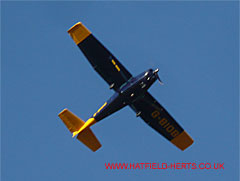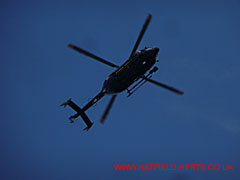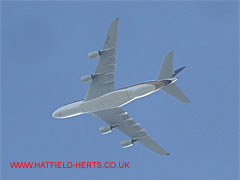Hobbies – Planespotting (in the skies over Hatfield)
Fears about the Ozone Layer means these days aircraft tend to be viewed in something of a negative light (although without the progress made possible by aviation speeding up human interaction we probably wouldn't know it existed). In the Thirties, as aviation took off, people across Britain clamoured for their towns to have their own airport. Despite now being cast in the role of villain (ironic given that the stars of aviation were the heroes of their day), aviation still holds a special place in some people's hearts.
Officially Hatfield's main connection with aviation ended with the closure of the airfield. However, the University of Hertfordshire still offers aeronautical engineering courses and the Hatfield branch of the Royal Aeronautical Society (RAeS) is still going strong. On rare occasions, you even get a helicopter landing on the helipad at the airfield. But as the site develops that is likely to cease altogether.
Still, on a clear day, you can see various types of flying craft and contraptions taking people up where we belong in the skies over Hatfield.
Dedicated planespotters note the aircraft registration and serial number – with them you can find out more about what you've just seen. UK registrations come under the Civil Aviation Authority. Sometimes the results can be surprising. But you need to be cautious with historic aircraft as they may have been painted to depict a famous pilot's plane, and have special permission to use the original registration or squadron markings. This is particularly true for classic military aircraft like Spitfires, Hurricanes and P-51 Mustangs.
Please note: most of the photographs on this page have been cropped, enlarged or otherwise digitally enhanced to improve their clarity.

Cessna 152 – G-BNKI, built in 1978. Operated by the Royal Air Force Halton Aeroplane Club.

Four engine passenger jet – probably an Airbus 340 series.

Reims Cessna F172P – G-BIOB, built in 1981.

Twin engine passenger jet – probably a Boeing 777 or an Airbus 320 series (hazy sky reduces the clarity).

Apache Longbow attack helicopter – operated by the Army Air Corps. The Longbow radar can be seen on the hub above the rotor blades.

Eurocopter EC-135 – operated by the Chiltern Air Support Unit, which provides police air support for the Thames Valley, Hertfordshire and Bedfordshire constabularies. Seen here on what was probably one of their more memorable missions – providing an aerial advance guard for Tornado, a newly-built steam engine on its first run to London (for pictures of the train – please see the Claims to Fame – Transportation page).

Lindstrand LBL 330A – G-CCWE, operated by Adventure Balloons. Humanity's oldest method of aerial transport (please see feature on Vincenzo Lunardi) seen a few hours before the latest appeared over Hatfield (details below).

Airbus A380 'Superjumbo' – 9V-SKF, operated by Singapore Airlines. This aircraft is the twelfth Airbus A380 made and the sixth to join the Singapore Airlines fleet. Currently, the latest and world's largest passenger aircraft.

Beech 18 – G-BKGL, operated by The Aircraft Restoration Company (trading name of Propshop Limited) based at Duxford. Over 9000 Beech 18s were built from 1937-69. This example has early US Army Air Corps markings but its registration details indicate it was built in 1952. Seen over Hatfield on Friday, 6 May 2011.

BAC Jet Provost – used by the RAF as a training plane (but has been deployed for ground attack by other air forces). Seen over Hatfield on 24 September 2011 (after the HAI march). Believed to be BAC Jet Provost Mk 52 (Ground attack export version of the Mk 4) operated by Swords Aviation – Construction number PAC/W/23905 (operated by the RAF as XS228 before being sold overseas – serving with the South Yemen and Singaporean Air Forces before coming back to the UK in 1983). Said to be the only Mark 52 still flying.

Yak 11 – training aircraft based on a famous WWII Russian fighter designed by Alexander Yakovlev (but mainly built post-WWII). Seen over Hatfield on Saturday, 8 September 2012. Was preceded by two other Yak aircraft (probably Yak 50's taking part at an airshow at Duxford that weekend). This example may be the Yak C-11 (Czech built; this example in 1945) operated by Robert Davies and the Woodchurch Warbirds Museum, where it is based.
Back to: Hobbies and Collections